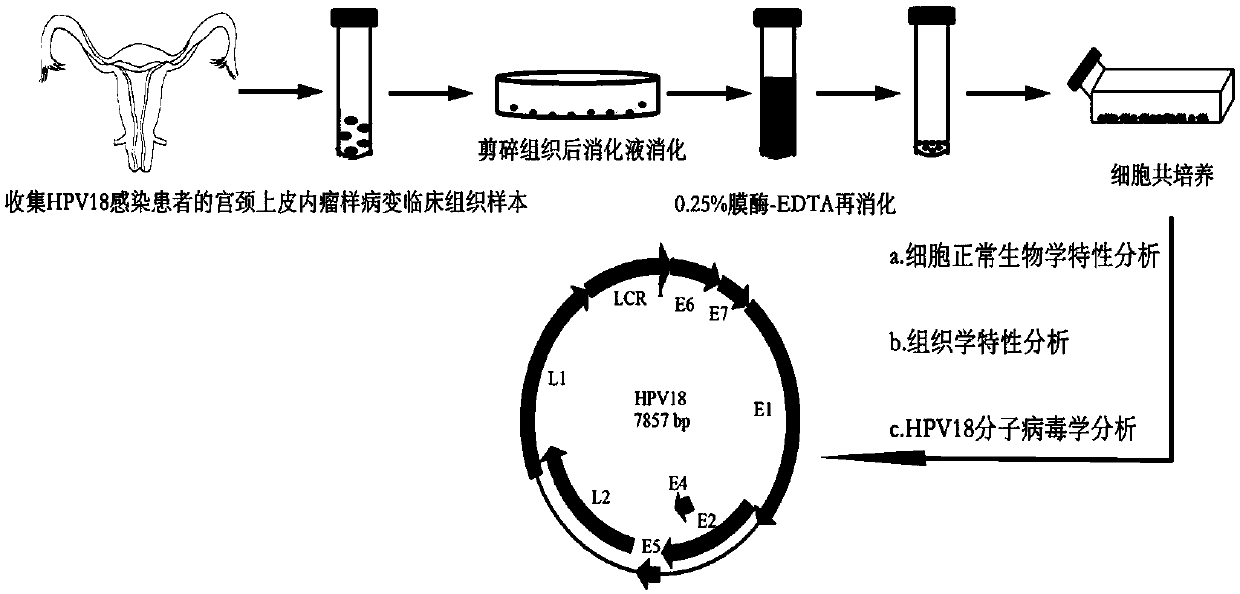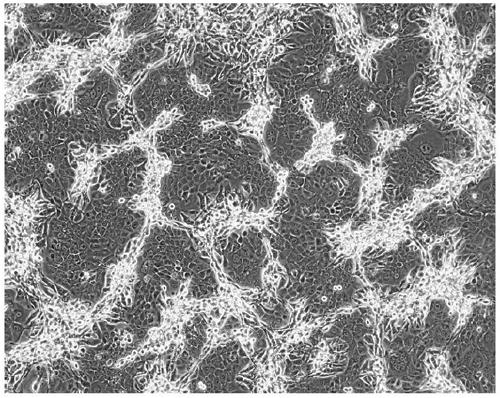Free-type HPV18-containing cervical epithelia interior tumor-like lesion cell line and application thereof
A diseased cell, free-type technology, applied in the field of microbial animal cell lines, can solve the problem that HPV cell lines cannot reflect the characteristics of the population
- Summary
- Abstract
- Description
- Claims
- Application Information
AI Technical Summary
Problems solved by technology
Method used
Image
Examples
Embodiment 1
[0043] [Example 1] Primary isolation and culture of human cervical intraepithelial neoplasia cells
[0044] (1) With the informed consent of the patient or patient guardian, collect clinical tissue samples of cervical intraepithelial neoplasia 1–2 cm from patients with HPV18 infection 3 (cubic centimeters), without other treatment.
[0045] (2) Preparation of digestive solution: HCIN medium containing 0.2 mg / mL of collagenase and dispase; wherein, HCIN medium is a medium mixed with DMEM and Ham's F 12 NUTRIENT MIX at a volume ratio of 4:1, and at the same time Add 4-6% fetal bovine serum (FBS), 1-3nM triiodothyronine (triiodothyronine), 0.4-0.65% insulin (insulin) reagent, 9-11ng / mL epidermal growth factor (epithelial growth factor ), 0.3-0.5 μg / mL hydrocortisone (hydro-cortisone), 35-45 μg / mL gentamicin (gentamicin), 45-55 nM calpeptin, 35-45 ng / ml recombinant human IL-1RA, and 3 μg / mL ml recombinant human R-Spondin-1.
[0046] (3) Wash the isolated tissue sample once wit...
Embodiment 2
[0053] [Example 2] Subculture of human cervical intraepithelial neoplasia cells
[0054] (1) When the human cervical intraepithelial neoplasia cells cultured in T25 or T75 culture flask proliferate to 70-90% abundance, wash the cells twice with 1×PBS (0.01M, pH 7.4), add 0.6 EDTA with a concentration of 0.02% in mL was gently shaken to make it fully contact with the cells on the culture flask, and after 20 seconds, tap the outer wall of the culture flask to make the mouse fibroblasts fall off the wall of the culture flask. After all the mouse fibroblasts were detached from the flask wall, EDTA was quickly removed, and the cells were washed 3 times with PBS.
[0055] (2) Digest the monolayer cells with 0.05% trypsin-EDTA for 5 min.
[0056] (3) Add 10 mL DMEM to neutralize the digestion reaction for 1 min, centrifuge at 1000 rpm for 5 min, and remove the supernatant.
[0057] (4) Resuspend the cell pellet in HCIN medium at a ratio of about 1:3, inoculate it in a culture flask...
Embodiment 3
[0060] [Example 3] Karyotype analysis and identification of human cervical intraepithelial neoplasia cells
[0061] (1) When human cervical intraepithelial neoplasia cells (1×10 6 ) in the exponential growth phase, add colchicine at a final concentration of 0.2 μg / mL, and continue culturing for 3.5 hours.
[0062] (2) Beat the cells repeatedly to make them fall off, and centrifuge at 2000rpm for 5 minutes to harvest the cells.
[0063] (3) Discard the supernatant, add 8 mL of 0.075 mol / L KCl solution pre-warmed at 37°C, gently blow and beat the cell mass to mix, and place at 37°C for hypotonic treatment for 25 minutes.
[0064] (4) Add 1 mL of freshly prepared fixative (methanol: glacial acetic acid = 3:1, v / v), carefully pipette, mix, and centrifuge at 2000 rpm for 5 minutes.
[0065] (5) Discard the supernatant, add 8 mL of fixative, pipette to form a cell suspension, and fix at room temperature for 20 minutes.
[0066] (6) Centrifuge at 2000rpm for 5 minutes, discard the...
PUM
 Login to View More
Login to View More Abstract
Description
Claims
Application Information
 Login to View More
Login to View More - R&D
- Intellectual Property
- Life Sciences
- Materials
- Tech Scout
- Unparalleled Data Quality
- Higher Quality Content
- 60% Fewer Hallucinations
Browse by: Latest US Patents, China's latest patents, Technical Efficacy Thesaurus, Application Domain, Technology Topic, Popular Technical Reports.
© 2025 PatSnap. All rights reserved.Legal|Privacy policy|Modern Slavery Act Transparency Statement|Sitemap|About US| Contact US: help@patsnap.com



